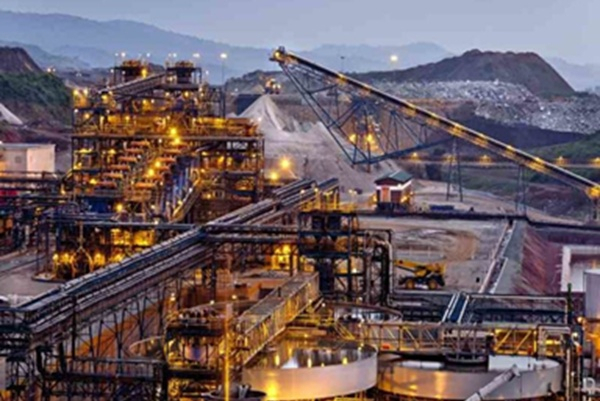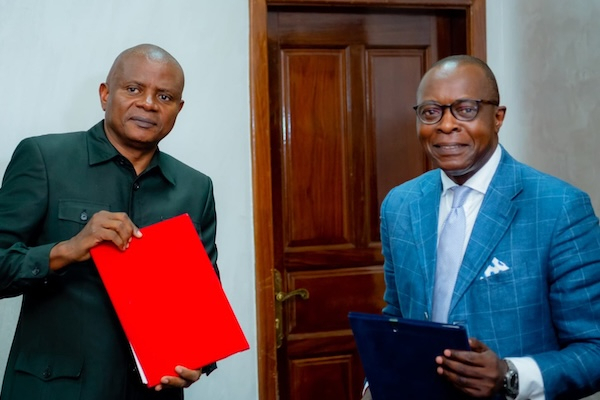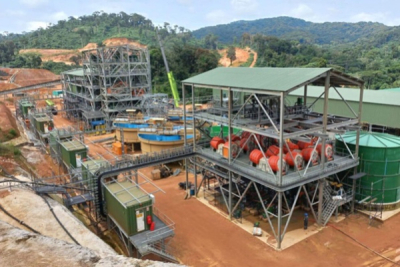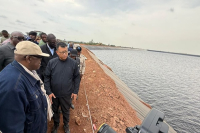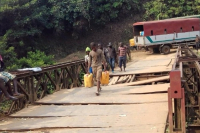
News (571)
Kibali, the Democratic Republic of Congo’s largest gold mine, produced 191,000 ounces of gold in the third quarter of 2025, Barrick Mining said in its financial report released on November 10. That’s a 21% increase from the 159,000 ounces recorded in the same period of 2024.
Barrick attributed the improvement to the ramp-up of open-pit operations at the Kibali mining complex, where extracted ore volumes rose by 133% during the quarter. The increase offset a decline in underground mine output.
From January to September 2025, total production reached 498,000 ounces, slightly below the 509,000 ounces recorded over the same period last year. To meet its annual target of between 688,000 and 755,000 ounces, Kibali will need to produce between 190,000 and 257,000 ounces in the fourth quarter. That would require an additional rise of at least 19.5%, following the 21% increase already achieved in the third quarter.
Such performance would benefit the Congolese state, which owns 10% of the mine through the state company SOKIMO and collects various taxes and other statutory fees in addition to dividends. These include a 30% corporate profit tax, a 3.5% mining royalty on gross sales, and a 0.3% local development contribution based on turnover.
A persistent challenge, however, is improving the valuation of the gold sold. Official data show that in 2024, artisanal cooperatives exported their gold at an average price of $72,873.9 per ton, compared with $53,542.4 per ton for Kibali, a difference of $19,331 per ton. This discrepancy is hard to explain, given that Kibali uses advanced technology and expertise that should, in principle, secure higher international market prices.
Pierre Mukoko
The Democratic Republic of Congo’s Minister of Rural Development, Grégoire Mutshail Mutomb, has signed a memorandum of understanding (MoU) with Primex CEO Guyshell Bengou. The agreement covers a pilot project to provide clean water to Lutendele, a community in the Mont-Ngafula commune on the outskirts of Kinshasa.
The project will install a solar-powered water supply system to improve access to drinking water for local residents.
According to a statement from the Ministry of Rural Development, the initiative is part of the Suminwa government’s plan to modernize rural infrastructure, with a key goal of ensuring sustainable access to safe water in rural and peri-urban areas.
Primex, the company leading the project, specializes in solar water systems, chemical-free purification, and hybrid renewable energy solutions. During the signing ceremony, Primex CEO Guyshell Bengou said that British engineers from Green Power Technology will take part in the technical phase, configuring the solar setup and calibrating the pumping units.
The final agreement has yet to be signed, but the Ministry said construction will begin soon at the Lutendele site. Functional and water-quality tests will be carried out before the model is replicated in other rural communities.
Boaz Kabeya
M23 rebels are trying to restart gold mining operations at the Twangiza gold site, operated by China’s Twangiza Mining in South Kivu province. The move follows a series of airstrikes by the Armed Forces of the Democratic Republic of Congo (FARDC) targeting the mine’s power facilities to disrupt the rebels’ illegal gold operations.
According to local outlet Tazama RDC, the Rwanda-backed rebels have been working since last week to resume gold extraction at the site, which they have controlled since May 2025. Several local sources say a new fuel storage tank has been delivered to replace one destroyed in the FARDC strikes. A backup generator that survived the October bombings is also being reactivated to restore power and allow for a partial restart of production.
Internal sources at Twangiza Mining estimate total losses since the occupation at nearly $75 million, including more than 500 kilograms of looted gold and extensive damage to or theft of equipment. The site’s profitability makes Twangiza one of M23’s key revenue sources, underscoring the group’s push to resume mining despite repeated army attacks.
In October, Reuters reported that the rebels were receiving assistance from Rwandan technicians to operate the mine and expand the extraction zone. That expansion reportedly involved forcing residents from their homes and destroying several nearby churches. The situation reflects M23’s strategy to build an economic base in areas under its control, even as military and diplomatic efforts continue to end the conflict.
Timothée Manoke
The Ministry of Agriculture launched a Steering Committee (COPIL) on November 7, 2025, to oversee two agricultural projects in Songololo, Kongo Central province, with a combined budget of $32 million. Implemented by the One Ancre Fund and initiated in December 2024 and June 2025, respectively, the projects had not yet entered their operational phase. According to Ministry Secretary-General Damas Mamba, the creation of the committee marks the formal start of implementation.
The COPIL is tasked with supervising and coordinating project execution. Its responsibilities include approving annual work plans and budgets, validating progress and financial reports, and reviewing recommendations from project monitoring committees. The committee will also address operational challenges, assess institutional arrangements, and approve any necessary budget adjustments in line with the procedures of the Central African Forest Initiative (CAFI) and the National REDD+ Fund (FONAREDD).
The first project, titled “Smallholder Deforestation-Free Agriculture,” is financed by CAFI with $2 million for an 11-month period. Officially launched on December 22, 2024, it seeks to encourage smallholders to adopt sustainable farming practices, particularly by moving away from slash-and-burn cultivation in forested areas.
The second project, “Supply of Inputs and Stabilization of Smallholder Agriculture,” benefits from $30 million in FONAREDD funding over three years. Launched on June 30, 2025, it aims to improve smallholder productivity and promote more stable and sustainable agricultural practices in the region.
Both initiatives focus on three core objectives: distributing certified local seeds to increase yields, promoting the “farmer-entrepreneur” model to support the creation of rural microenterprises, and introducing Payments for Environmental Services (PES) to reward sustainable farming and reforestation.
Ronsard Luabeya
The World Bank expects tin prices to rise by around 10% in 2025, followed by further gains of 3% in 2026 and 1.5% in 2027.
In its October 2025 Commodity Markets Outlook, the institution forecasts that prices will climb from $30,066 per ton in 2024 to $33,000 in 2025, $34,000 in 2026, and $34,500 in 2027. The outlook for the first two years was revised upward by $2,000 and $2,500, respectively, from the April 2025 projections.
The Bank attributes the rise to persistent tightness in global supply. “The global tin market is likely to remain tight, given the limited pipeline of new projects and continued vulnerability to geopolitical and operational disruptions,” the World Bank said.
Prices are expected to keep increasing despite a partial recovery in supply, particularly in Indonesia, where export license delays have been resolved, and in Myanmar, where several mines idled since 2023 have resumed production. Global demand is set to stay strong, supported by rising output of semiconductors, solar panels, and other energy-transition technologies.
The Democratic Republic of Congo (DRC), one of Africa’s leading tin producers, is closely watching these developments. In 2024, the country exported 42,953 tons of tin concentrate, according to official data. Most exports came from Alphamin, operator of the Bisie mine (26,932 tons), with the rest (15,853 tons) from artisanal miners.
Price Gap Limits DRC Revenue
The DRC is benefiting little from the price rally due to the lack of local refining capacity. The World Bank’s benchmark prices refer to refined tin, while the DRC exports only concentrate. This gap limits value addition, reduces earnings for artisanal miners, and cuts tax revenue for both central and provincial governments.
In 2024, Alphamin’s 26,932 tons of concentrate exports were valued at $348.6 million, or roughly $12,946 per ton. By comparison, the 17,865 tons of refined metal derived from that output were sold for $542 million, averaging more than $30,300 per ton, according to company data. The difference highlights the significant fiscal losses faced by the state, which collects royalties on concentrate rather than on refined metal.
Congolese tin exports could decline in 2025 amid a worsening security situation in the east of the country, the main production area. Facing the advance of AFC/M23 rebels, Alphamin suspended operations in March before resuming mid-April but later revised its annual forecast downward. The company now expects to produce 18,500 tons in 2025, compared with an initial target of 20,000 tons.
The ongoing conflict is also likely to cut into artisanal exports through formal channels. A 2022 Global Witness report estimated that about 90% of 3T minerals (tantalum, tin, and tungsten) exported by Rwanda were already being sourced illegally from the DRC.
Pierre Mukoko
-
The Democratic Republic of Congo (DRC) Minister of Digital Economy, Augustin Kibassa Maliba, met with Alibaba Group and Isoftstone Corporate officials in China.
-
The discussions focused on adapting the Chinese e-commerce model for implementation in the DRC.
-
The parties agreed to create a joint working group to formulate concrete proposals for e-commerce development.
The Democratic Republic of Congo (DRC) Minister of Digital Economy, Augustin Kibassa Maliba, met with executives from Alibaba Group and Isoftstone Corporate, two major players in the digital sector. The meeting occurred on the sidelines of the Sino-African Forum on Economic, Trade, and Cultural Cooperation, held on November 7, 2025, in Jinhua, China.
The Ministry of Digital Economy reported the exchanges focused on the Chinese e-commerce model and its potential adaptation in the DRC. Participants addressed several key subjects, including regulation, technology, and establishing an effective digital ecosystem.
Consequently, the parties agreed to establish a joint working group. This group holds the mandate of deepening the reflection and formulating concrete proposals for e-commerce development in the DRC. The Ministry specified technical meetings will occur in the coming days. These meetings aim to finalize a strategic report for Minister Kibassa. This document will serve as the foundation for implementing a simplified and accessible national e-commerce model, particularly benefiting young Congolese entrepreneurs.
Alibaba Group, which Jack Ma founded in 1999, reaffirmed its interest in the African market. The Chinese giant considers the DRC a strategic hub for expanding its activities across the continent. Alibaba operates across online commerce, cloud computing, digital finance, logistics, and entertainment. The company utilizes platforms such as Alibaba.com, Taobao, Tmall, AliExpress, and Alipay, forming an integrated ecosystem connecting merchants, consumers, and service providers.
Founded in 2001, Isoftstone Group specializes in information technologies and digital transformation. The company provides solutions in artificial intelligence, cloud computing, big data, and smart cities. Isoftstone targets governments and companies operating in the telecommunications, energy, transport, finance, and health sectors.
This article was initially published in French by Ronsard Luabeya
Adapted in English by Ange Jason Quenum
The copper and cobalt sites of the Chinese company Congo Dongfang Mining (CDM) in Lubumbashi have been suspended. The measure, announced on November 6, 2025, by the Democratic Republic of Congo’s Minister of Mines, Louis Watum Kabamba, will last an initial three months.
It targets the company’s operations following a major industrial pollution incident that affected several neighborhoods across the city.
During the suspension period, which may be extended, the copper and cobalt producer is required to continue paying all site staff in full, the minister said. CDM must also repair the environmental damage, compensate affected residents, and pay fines provided for in the Mining Code and applicable regulations.
Local media reported that contaminated water began leaking from CDM’s facilities in the Kasapa area of the Annexe commune, north of Lubumbashi, as early as Monday, November 3. The situation worsened sharply on November 4, when large volumes of water from the company’s retention pond spilled into surrounding areas, flooding in particular the Moïse market, which serves much of the city’s north.
Retention ponds are industrial basins designed to store and neutralize liquid effluents from mineral processing before discharge into the environment. A breach can release acidic, heavy metal-laden effluents that severely contaminate soil, homes, and waterways.
Eyewitnesses reported residents suffering skin burns after contact with the water, while viral images on social media showed dead domestic animals and fish floating in polluted streams, including the Lubumbashi River.
Minister Watum rushed to Lubumbashi on the night of November 5-6 to assess the situation. Onsite, CDM officials attributed the leak to a falling stone that they said damaged the pond’s impermeable lining and caused the toxic discharge.
The explanation failed to convince the minister, who posted on his X (formerly Twitter) account that the company’s discharge pond “does not meet any environmental standards, lacking an impermeable lining, structural stability, control mechanisms, or an emergency plan.”
Local media said the company took emergency measures to contain the pollution, including building a lime barrier to neutralize acidic water and using a pump to divert contaminated liquid into an old basin.
This is not the first incident involving CDM. Residents previously accused the company in 2022 of dumping polluted water into sewage systems and releasing toxic fumes from its operations.
The latest episode has reignited debate over the environmental accountability of mining companies in the DRC and the capacity of authorities to enforce strict standards in a sector often criticized for practices that endanger communities and ecosystems.
Timothée Manoke
Rehabilitation work on the strategically important Ulindi Bridge on National Road 31 (RN31) in Maniema province is now scheduled, a move expected to significantly boost agricultural and commercial trade in the region.
The announcement was made on November 4, 2025, in Kindu by Matthieu Kamulete Amisi, interim provincial coordinator of the Inclusive and Resilient Rural Development Support Program (PADRIR), during the second Conference on Mines, Energy and Infrastructure.
Amisi confirmed that the necessary funding for the project has been secured from the Arab Bank for Economic Development in Africa (BADEA) and the OPEC Fund for International Development (OFID). While the total cost was not disclosed, technical studies are slated to begin in 2026, with rehabilitation work on the bridge expected to start in 2027.
The Ulindi Bridge, located between the towns of Kailo and Punia, is a key transport link for the province. Its restoration will reopen the RN31 to full traffic, connecting Kindu with major cities such as Kisangani, Goma, and Bukavu, and improving access to National Roads 1 and 2.
The project aims to ease the transport of farm goods and improve mobility for local residents. It is part of the PADRIR program, which seeks to strengthen road infrastructure, support regional economic growth, and improve market access in rural areas.
Boaz Kabeya
Fuel and food supplies to the city of Bunia in eastern Democratic Republic of Congo are at risk after a key section of National Road No. 27 (RN27), which links Bunia to Mahagi in Ituri province, became almost impassable.
The disruption stems from the severe deterioration of the Tchulu Bridge–Jina stretch, located about 40 kilometers north of Bunia. Heavy rains have turned the road into a quagmire, leaving around 450 trucks carrying goods and fuel stranded, according to several local sources.
The ongoing blockage threatens Bunia’s supply lines, where stocks of essential goods are reportedly dwindling, fueling fears of inflation, Radio Okapi reported, citing a representative of local civil society.
Transport operators had already raised alarms about the road’s poor condition in September. They now say the 180-kilometer journey between Bunia and Mahagi takes at least four days to complete, up from about four hours before.
Despite the road’s critical state, a rehabilitation project has been underway on this section for the past two years. The work was awarded to the company ORC Construct under a contract lasting three to five years, funded by the National Road Maintenance Fund (FONER). However, civil society organizations contend that progress has been insignificant, calling the project ineffective as the road continues to deteriorate.
As a vital trade route, the RN27 links Ituri to several East African countries, including Uganda, Kenya, and Tanzania. Its prolonged blockage threatens to inflict heavy damage on the local economy and is expected to push up the cost of living in Bunia.
Ronsard Luabeya
The governments of the Democratic Republic of Congo (DRC) and Rwanda have initialed the draft Regional Economic Integration Framework (REIF) in Washington, D.C., on November 7, 2025, with U.S. facilitation.
The framework defines priority areas for economic cooperation and development between the two neighbors and is part of efforts to implement their June 27, 2025, peace agreement. The initialing took place during the fourth meeting of the joint monitoring committee overseeing the accord.
This step clears the way for the framework’s official signing, initially expected on September 27, 2025. However, Kinshasa reiterated that progress on the REIF depends on full implementation of the security commitments contained in the peace deal.
“The framework will take effect once the Concept of Operations (CONOPS) and the operational order agreed by both sides are properly implemented,” the DRC Ministry of Communication and Media said in a statement released a day after the signing. “For the DRC, lasting peace must come before economic cooperation.”
Adopted in Luanda in October 2024, the CONOPS outlines plans to neutralize the Democratic Forces for the Liberation of Rwanda (FDLR) and ensure the withdrawal of Rwandan forces from Congolese territory. The operational order, setting out implementation details, was due to take effect on October 1, 2025, but its enforcement remains uncertain.
The DRC’s communication ministry said the joint monitoring committee acknowledged delays in carrying out the peace accord and that both parties agreed on new measures to speed up implementation, though no specifics were disclosed.
The execution of the CONOPS also partly depends on stalled negotiations between the DRC and the AFC/M23 rebels. Talks meant to produce a final agreement by August 18, 2025, under the Doha declaration of principles signed on July 19, have yet to yield results. This indicates that the resumption of economic cooperation between Kinshasa and Kigali remains uncertain for now.
The REIF targets five areas of cooperation: agriculture, energy, mining, telecommunications, and infrastructure. As set out in the peace accord, both countries aim to use the framework to boost cross-border trade, attract investment in critical mineral supply chains, and enhance transparency in resource management. The goal is to curb illicit trade networks and promote shared prosperity, particularly for local communities.
U.S. officials said successful implementation of the framework could attract new international investors, including American firms. Several companies in the critical minerals and energy sectors are pushing for the swift conclusion of the deal, which underpins multiple regional development projects.
Pierre Mukoko
More...
Rawbank, a leading financial institution in the Democratic Republic of Congo (DRC), has been named the country’s safest bank in Global Finance magazine’s World’s Safest Banks 2025 ranking.
The award, announced on November 6, 2025, is based on credit ratings from major rating agencies, including Moody’s, Standard & Poor’s, and Fitch Ratings, as well as each institution’s asset size and overall financial strength.
Rawbank succeeds Equity Banque Commerciale du Congo (Equity BCDC), the 2024 winner. According to Global Finance, the change follows the withdrawal of Equity BCDC’s Moody’s rating in December 2024, after its parent company, Kenya’s Equity Group Holdings, decided to consolidate ratings at the group level.
With a B3 rating and stable outlook from Moody’s since May 2024, Rawbank became the only Congolese bank holding an active international rating , a key requirement for inclusion in the 2025 ranking of the world’s safest banks.
The bank said its performance reflects ongoing investments in digitalization, through its IllicoCash and RawbankOnline platforms, and its reinforced compliance framework, including stronger anti-money-laundering controls. It also cited progress in corporate governance, such as the creation of a Corporate Social Responsibility and Sustainability Committee, as factors that favorably influenced Global Finance's assessment.
“This recognition reflects Rawbank’s discipline, professionalism, and commitment to maintaining the highest standards of reliability and service,” said Mustafa Rawji, Rawbank’s Chief Executive Officer. “It rewards the collective efforts of our teams and the continued trust of our clients. We will keep investing in stability, innovation, and compliance to make Rawbank a benchmark for banking in Africa, from the DRC.”
DR Congo’s banking leader
As the largest bank in the DRC, Rawbank controls about 30% of the market, serves more than two million clients, and reported nearly $5 billion in assets, according to its 2024 annual report.
The bank’s net income rose 11.4% to $212.7 million, while its solvency ratio exceeded 14%, comfortably above the Central Bank of Congo’s minimum regulatory threshold.
According to Moody’s, these indicators show a strong capacity to absorb macroeconomic shocks, despite an environment marked by exchange-rate volatility and dependence on the mining sector.
Series of international distinctions
The Global Finance award adds to several other international honors Rawbank has earned recently. The bank was named Best Bank in DRC 2024 by Euromoney, Best Digital Bank 2024 for the DRC by Global Finance, and was also recognized for compliance and governance excellence by The Banker and the Financial Afrik Awards 2024.
These awards are expected to strengthen confidence in deposit protection, improve access to international credit lines from institutions such as the IFC, African Development Bank (AfDB), and Proparco, and enhance Rawbank’s ability to finance businesses and households through its expanding deposit base.
Pierre Mukoko & Boaz Kabeya
The Democratic Republic of Congo's Industry Promotion Fund (FPI) and the International Finance Corporation (IFC) are exploring a collaboration to co-finance industrial projects in the country.
FPI Director General Hervé Claude Ntumba met with IFC Country Representative Malick Fall on Nov. 5, 2025, to discuss priority sectors for potential joint support.
According to a note from the FPI, the discussions focused on aligning the two institutions’ interventions in sectors deemed critical to developing the Congolese industrial base, including agriculture, energy, mining, telecommunications, and infrastructure.
Beyond co-financing projects, the two organizations are also considering establishing joint programs for training and capacity building to support local Congolese expertise.
Ntumba emphasized that the DRC’s economic recovery relies on close cooperation between local and international financial institutions. He stressed that the country's development requires sustainable partnerships built on a shared vision of progress.
The meeting comes as the IFC is already working with Congolese authorities on several initiatives, including establishing a capital market, developing an accessible and sustainable housing finance ecosystem, and implementing major projects in the power and agricultural sectors.
Since 2021, the IFC has invested over $550 million in the DRC, primarily in telecommunications, the financial sector, and energy.
Ronsard Luabeya
The Democratic Republic of Congo is nearing a $456 million disbursement from the International Monetary Fund (IMF) under its three-year economic and financial program.
The amount includes $268 million from the Extended Credit Facility (ECF) and $188 million from the Resilience and Sustainability Facility (RSF), according to a source familiar with the matter.
Following a mission from Oct. 22 to Nov. 5, 2025, IMF staff and Congolese authorities reached a staff-level agreement on the second review of the ECF and the first review of the RSF, the IMF said in a statement. The agreement marks a key step toward releasing the funds.
The next stages involve review by the IMF’s Management and approval by its Executive Board, scheduled to meet in December 2025. A favorable decision, which typically follows such agreements, would trigger the immediate disbursement.
Unlike previous tranches, most of the upcoming funds will be allocated as budget support, transferred directly to the Treasury to support the national budget. An IMF official said $188 million from the RSF and $189 million from the ECF will go toward budget support, totaling $377 million.
The remaining $79 million will be credited to the Central Bank of Congo’s account at the Bank for International Settlements to strengthen the country’s foreign reserves.
The IMF noted that the DRC’s external stability has improved, driven by growing reserves and a narrower current account deficit, though reserves remain below the recommended adequacy level. Persistent insecurity in the eastern provinces and recurring health crises, such as Ebola outbreaks, continue to strain public finances.
For 2026, the DRC projects a budget of 59.02 trillion Congolese francs ($20.3 billion) based on the average exchange rate used for fiscal assumptions. Defense spending will represent nearly 15% of the total, or 7.93 trillion francs ($2.7 billion). The overall budget is up 16.4% from the revised 2025 finance law. To help fund it, the government is relying on external budget support, projected to rise 28.1% to 3.80 trillion francs ($1.3 billion).
Pierre Mukoko
The Democratic Republic of Congo's Ministry of Mines revoked the mining rights of seven companies in late October 2025 as part of its policy to enforce stricter compliance in the sector. The revocations were issued for failure to pay annual surface rights fees.
According to a list published by the Mining Cadastre (CAMI) on Nov. 3, Geocore was the most affected entity, losing two separate mining titles. One of the titles, granted in 2021, covered five mining squares in the Nyunzu and Kongolo territories of Tanganyika province, authorizing the company to conduct exploration and prospecting for gold, cassiterite, coltan, and wolframite.
Another notable firm was Regal Maniema, which had its Research Permit No. 3279 revoked. The company had previously faced the threat of forfeiture for the same reason, following a similar procedure initiated in 2021 over unpaid fees for the 2019 financial year.
These forfeiture decisions are based on Article 289 of the DRC's 2018 Revised Mining Code. The code allows affected companies to appeal the decision before competent authorities within 30 days of notification and publication. If no appeal is filed, the forfeiture is formally registered with the Mining Cadastre and published in the official gazette.
Under the Mining Code, the payment of surface rights is the second main condition for maintaining the validity of a mining title, after providing proof of the effective start of exploration or exploitation work. These rights are due annually, calculated based on the perimeter area and the permit’s validity period. The fees range from $0.03 to $1.14 per hectare, payable in Congolese francs at the current exchange rate.
Timothée Manoke






